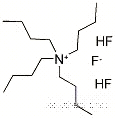-
Name
TETRA-N-BUTYLAMMONIUM DIHYDROGENTRIFLUORIDE
- EINECS
- CAS No. 99337-56-1
- Density 0,966 g/cm3
- Solubility
- Melting Point
- Formula C16H38F3N
- Boiling Point
- Molecular Weight 301.47
- Flash Point 13 °C
- Transport Information
- Appearance clear light yellow to brown solution
- Safety 53-45-36/37/39-26-16
- Risk Codes 45-35-23/24/25-11
-
Molecular Structure
-
Hazard Symbols
 C,
C, F
F
- Synonyms N,N,N-Tributylbutan-1-aminium fluoride hydrofluoride (1:1:2);
- PSA 0.00000
- LogP 3.07300
Tetra-n-butylammonium dihydrogen trifluoride Specification
The Tetra-n-butylammonium dihydrogen trifluoride, with the CAS registry number 99337-56-1, is also known as N,N,N-Tributylbutan-1-aminium fluoride hydrofluoride (1:1:2). It belongs to the product categories of Ammonium Polyhalides, etc. (Quaternary); Fluorinating Reagents; Fluorinating Reagents & Building Blocks for Fluorinated Biochemical Compounds; Fluorination; Halogenation; Nucleophilic Fluorinating Reagents; Quaternary Ammonium Compounds; Synthetic Organic Chemistry. This chemical's molecular formula is C16H38F3N and molecular weight is 301.47483. Its IUPAC name is called tetrabutylazanium fluoride dihydrofluoride. The product should be sealed and stored in cool and dry place. What's more, it should be protected from strong oxides.
Physical properties of Tetra-n-butylammonium dihydrogen trifluoride: (1)H-Bond Donor: 2; (2)H-Bond Acceptor: 3; (3)Rotatable Bond Count: 12; (4)Exact Mass: 301.295635; (5)MonoIsotopic Mass: 301.295635; (6)Topological Polar Surface Area: 0; (7)Heavy Atom Count: 20; (8)Formal Charge: 0; (9)Complexity: 116; (10)Isotope Atom Count: 0; (11)Defined Atom StereoCenter Count: 0; (12)Undefined Atom StereoCenter Count: 0; (13)Defined Bond StereoCenter Count: 0; (14)Undefined Bond StereoCenter Count: 0; (15)Covalently-Bonded Unit Count: 4.
When you are using this chemical, please be cautious about it as the following:
This chemical may destroy living tissue on contact. It may catch fire in contact with air and only need brief contact with an ignition source which has a very low flash point or evolve highly flammable gases in contact with water. In addition, it is toxic by inhalation, in contact with skin and if swallowed. In case of contact with eyes, you should rinse immediately with plenty of water and seek medical advice. Whenever you will contact it, please wear suitable protective clothing, gloves and eye/face protection.
You can still convert the following datas into molecular structure:
(1)Canonical SMILES: CCCC[N+](CCCC)(CCCC)CCCC.F.F.[F-]
(2)InChI: InChI=1S/C16H36N.3FH/c1-5-9-13-17(14-10-6-2,15-11-7-3)16-12-8-4;;;/h5-16H2,1-4H3;3*1H/q+1;;;/p-1
(3)InChIKey: MRXQMNWIADOAJY-UHFFFAOYSA-M
About|Contact|Cas|Product Name|Molecular|Country|Encyclopedia
Message|New Cas|MSDS|Service|Advertisement|CAS DataBase|Article Data|Manufacturers | Chemical Catalog
©2008 LookChem.com,License: ICP
NO.:Zhejiang16009103
complaints:service@lookchem.com Desktop View
